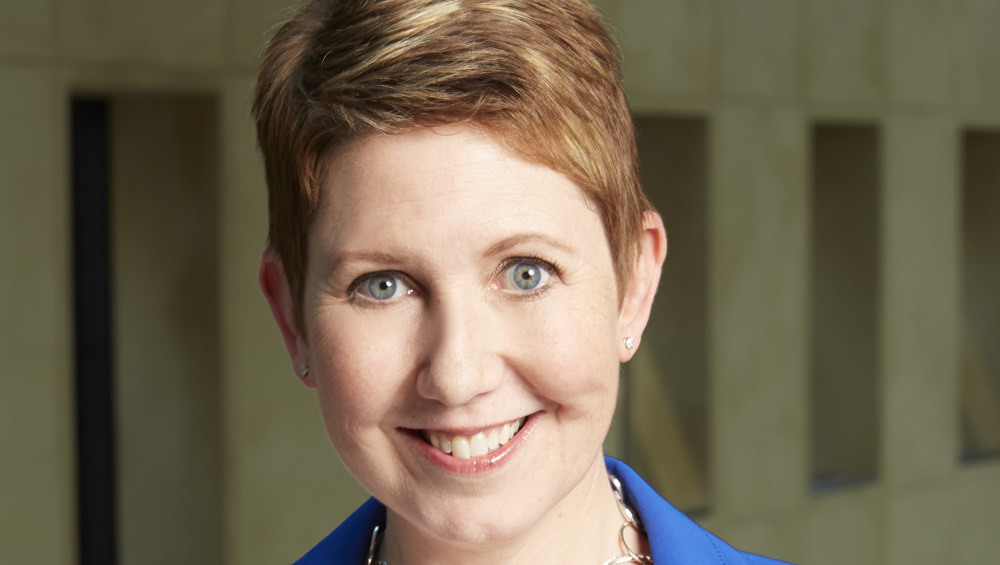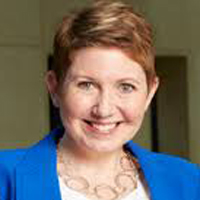
Hearst Aims For News Transparency, Relatability


Barbara Maushard
Local broadcast news isn’t broken, but it needs to reaffirm its core values of trust and transparency, says Barb Maushard, Hearst Television’s SVP of news.
Maushard says that much is still working in the broadcast paradigm, though if local news wants to find its next generation of viewers, it needs to do so in a voice they can relate to and to be on the platforms – including social and OTT — where those audiences have moved.
Since rising to her position in 2017, Maushard has led Hearst Television to a number of honors for its coverage, including three National Murrow Awards, four National Headliner Awards and in 2019, 26 Regional Murrow Awards and the NAB Service to America Award for its election coverage.
Maushard has worked at four Hearst stations since 1997, serving as news director at three of them: KHBS-KHOG Fort Smith-Fayetteville, Ark.; WISN Milwaukee; and WESH Orlando, Fla. She began her career at WHOI in her hometown of Peoria, Ill., later working at WCMH Columbus, Ohio, and WMAR Baltimore.
Among other industry roles, Maushard serves on the boards of NBC News Channel, the Kneeland Project for Responsible Journalism and the Library of American Broadcasting Foundation. She has also been vice chair of the ABC News Directors Advisory Board and is a member of the Radio Television Digital News Association.
In this exclusive interview with TVNewsCheck Special Projects Editor Michael Depp, Maushard discusses Hearst’s forays into new territory like Facebook Watch, how the company deals with the growing problem of newsmaking but graphic social videos and how its investigative and political coverage is expanding.
An edited transcript.
Recently, newsrooms around the globe grappled with whether or how they should use graphic video footage from the Christchurch, New Zealand, mass shooting. How did Hearst respond to that, and how have you developed ethical guidelines around that kind of scenario?
When it comes to video, we want to make sure we’re doing it right. We want to be responsible and careful and do the right thing, so any time there’s a piece of graphic or risky video, we have put into policy in our group that there should be a second set of eyes. Some newsrooms will say there has got to be a third set of eyes. It slows down the process, but I’d rather we be correct and responsible. Everything is going to be a local decision at some level because some markets are more accepting of different things.
So this is decentralized and you let the newsrooms make those decisions?
When it comes to digital platforms, generally we have some centralized operations that can push content out, but the stations can make decisions as to whether or not they want to use that. Stations will make decisions, but we will provide guidance.
When you look at the structure and format of a local newscast, what most needs to be shaken up or reimagined? How are you doing that at Hearst?
One of the things that doesn’t need to be shaken up is the quality journalism that we’re providing in our markets. There’s a lot of talk about being innovative and creative, and we have to be smart about responding to our audiences. We need to be sure that we’re getting to them with information that is valuable, reliable and accurate. We have to be interesting and compelling, but I don’t think those things should stand in the way of the quality, trusted journalism that is expected.
In a recent study that we conducted with SmithGeiger, it reinforced the notion that local news is still the most trusted. We understand what’s happening there and we work from a position of non-bias. We have to stay in that lane and still find an opportunity to relate to the audience.
Let’s drill down into something tangible on the relatability front, then. What does that look like that’s different from today?
It’s about content choice. It’s about style and tone. We want to have people who are still anchoring, reporting and hosting for us that are relatable. That in large part comes from knowing what the community wants.
We launched a big effort, Project CommUNITY, which is a year-long initiative drilling down into some of the issues that divide us in these communities and what’s being done to unite [them]. That makes us more relatable.
I don’t know that we need to take the newscast and turn it upside down. We need to make sure as we’re doing our jobs as journalists, we’re identifying what really matters and finding unique ways to communicate that.
Do you foresee a time when the local newscast might look radically different than right now — say doing away with anchors, for instance?
I don’t. There’s great value in knowing and trusting those people in the local markets. We have a connection because we’re part of those communities.
What are the steps you have to take across the group to connect with younger audiences?
Young people, while they aren’t watching local news on television every day, there are still a large number of them that will see a local newscast on TV every week and there’s an even larger number that will see local news somewhere on a digital platform. We’re working to reach those people on the various social platforms where they’re spending their time.
There are a couple of initiatives we’ve embarked on from a primarily social effort. The Facebook Watch program we have, Dispatches from the Middle, is in its second season. It’s an opportunity for us to take interesting stories from local markets produced for social — including interviews with our reporters, who give background on how the story was covered — and build [them] out a bit.
There’s a Stitch product that’s basically a national footprint for heartwarming stories. Through our digital teams we identify stories from our stations across the group that can be repurposed and reproduced to reach various audiences.
Is it ultimately going to be necessary to have a strong OTT presence to find future audiences? If so, what steps will Hearst take to realize that for its newscasts?
It’s going to be important to have a strong OTT presence. It’s important for us to continue to explore and identify the best approach.
In your view, is it the case that you can’t just take a newscast and transport it to another platform? Do you have to be bespoke for each individual platform?
We’re all still figuring that out. At one point, we took content and tried to make it super different for the digital platforms, and what we found is we don’t have to. It’s all about good storytelling and important information. It’s a constant exploration and evolution.
How are your newsrooms and workflows coping with the endless proliferation of platforms? Is that sustainable?
It’s a challenge every single day and it is a constant discussion. It’s tough. We ask our leadership to do good quality journalism and we’ve expanded our number of hours of news on television in the last several years rather than retract it. We’re still putting a ton of local broadcast out and a ton of social content and we’re looking at OTT.
What are you learning from your experience of producing Dispatches from the Middle on Facebook Watch?
One of the takeaways is there is an audience, people are interested in these stories. We’re identifying stories that are interesting and giving them a little more, the sort of inside look we don’t do as much on television. Giving a little more insight and more of a personal touch really has helped that program.
Local TV news brands hold an edge over their national counterparts in terms of audience trust, but the drumbeat of “fake news” has hardly quieted down in the background. What have you substantively had to do to reaffirm trust with your own viewers across your markets?
It’s important for us to always remember to be transparent and honest. We want to make sure people understand how we’re getting to the information. We take our time to ensure we’re not making mistakes, and if we make mistakes, we come clean about it. Those anchors and reporters — some of whom spend 20 or 30 years in those markets — are trusted because they’re part of the community and they have proven their trust by the work that they do.
Just under a year ago you launched a national investigative unit within your D.C. bureau under Mark Albert. How big is that unit, and what has been its output?
I’ve got three people specific to that unit. I have an entire D.C. bureau that contributes to the unit, and I have an entire company that’s contributing content and support.
How does the investigative unit work with local newsrooms?
It’s a combination of things. We have a taskforce of individuals around the company who meet monthly on a call to communicate ideas. The unit will talk about a story that they’re working on and seek assistance from stations that are also working on it or are able to help.
The investigative unit, and Mark in particular, is a machine and really amazing at digging in and gathering information that can then be spread out to local markets to help support the bigger story. He’ll do something from a national perspective, generally with local elements, and then provide a lot of material to the local stations.
The stakes for media can hardly be higher than the next presidential election. How are you preparing to cover that on both your newscasts and other platforms in a way that is different from previous elections?
We’re still formulating the plan for what Commitment 2020 will look like. We expanded our D.C. bureau last year [and] brought in another correspondent. And we’re continuing to explore whether there should be additional resources. Our Washington bureau will continue to lead the way in a lot of coverage as it has done. You’re right: the stakes couldn’t be higher. We’re going to be aggressively covering this, seeking out more debates and more opportunities to get with the candidates.
President Trump’s Twitter habit hasn’t abated at all and that has created stress in newsrooms with its middle-of-the-night tweetstorms. How much does having to keep up with that effect your newsrooms at the local level?
The endless barrage of news, period, causes stress on the newsrooms. We have to stay on top of everything like we never had. But our newsrooms’ focus is really about the issues that are important in those local markets. It’s never been harder to stay on top of everything, but it has never been more important.
Looking ahead, what are your biggest concerns or worries about the news ecosystem overall?
My concerns are making sure our viewers are able to identify trusted sources. It’s important that folks who are looking for quality, real journalism are able to find it. My hope is that we can all be part of ensuring that audiences can find it and get what they need and can benefit from that great journalism that’s being done.


































Comments (0)